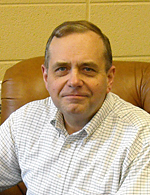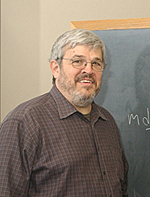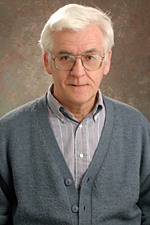


- Rozovsky wins prestigious NSF Early Career Award
- UD students meet alumni, experience 'closing bell' at NYSE
- Newark Police seek assistance in identifying suspects in robbery
- Rivlin says bipartisan budget action, stronger budget rules key to reversing debt
- Stink bugs shouldn't pose problem until late summer
- Gao to honor Placido Domingo in Washington performance
- Adopt-A-Highway project keeps Lewes road clean
- WVUD's Radiothon fundraiser runs April 1-10
- W.D. Snodgrass Symposium to honor Pulitzer winner
- New guide helps cancer patients manage symptoms
- UD in the News, March 25, 2011
- For the Record, March 25, 2011
- Public opinion expert discusses world views of U.S. in Global Agenda series
- Congressional delegation, dean laud Center for Community Research and Service program
- Center for Political Communication sets symposium on politics, entertainment
- Students work to raise funds, awareness of domestic violence
- Equestrian team wins regional championship in Western riding
- Markell, Harker stress importance of agriculture to Delaware's economy
- Carol A. Ammon MBA Case Competition winners announced
- Prof presents blood-clotting studies at Gordon Research Conference
- Sexual Assault Awareness Month events, programs announced
- Stay connected with Sea Grant, CEOE e-newsletter
- A message to UD regarding the tragedy in Japan
- More News >>
- March 31-May 14: REP stages Neil Simon's 'The Good Doctor'
- April 2: Newark plans annual 'wine and dine'
- April 5: Expert perspective on U.S. health care
- April 5: Comedian Ace Guillen to visit Scrounge
- April 6, May 4: School of Nursing sponsors research lecture series
- April 6-May 4: Confucius Institute presents Chinese Film Series on Wednesdays
- April 6: IPCC's Pachauri to discuss sustainable development in DENIN Dialogue Series
- April 7: 'WVUDstock' radiothon concert announced
- April 8: English Language Institute presents 'Arts in Translation'
- April 9: Green and Healthy Living Expo planned at The Bob
- April 9: Center for Political Communication to host Onion editor
- April 10: Alumni Easter Egg-stravaganza planned
- April 11: CDS session to focus on visual assistive technologies
- April 12: T.J. Stiles to speak at UDLA annual dinner
- April 15, 16: Annual UD push lawnmower tune-up scheduled
- April 15, 16: Master Players series presents iMusic 4, China Magpie
- April 15, 16: Delaware Symphony, UD chorus to perform Mahler work
- April 18: Former NFL Coach Bill Cowher featured in UD Speaks
- April 21-24: Sesame Street Live brings Elmo and friends to The Bob
- April 30: Save the date for Ag Day 2011 at UD
- April 30: Symposium to consider 'Frontiers at the Chemistry-Biology Interface'
- April 30-May 1: Relay for Life set at Delaware Field House
- May 4: Delaware Membrane Protein Symposium announced
- May 5: Northwestern University's Leon Keer to deliver Kerr lecture
- May 7: Women's volleyball team to host second annual Spring Fling
- Through May 3: SPPA announces speakers for 10th annual lecture series
- Through May 4: Global Agenda sees U.S. through others' eyes; World Bank president to speak
- Through May 4: 'Research on Race, Ethnicity, Culture' topic of series
- Through May 9: Black American Studies announces lecture series
- Through May 11: 'Challenges in Jewish Culture' lecture series announced
- Through May 11: Area Studies research featured in speaker series
- Through June 5: 'Andy Warhol: Behind the Camera' on view in Old College Gallery
- Through July 15: 'Bodyscapes' on view at Mechanical Hall Gallery
- More What's Happening >>
- UD calendar >>
- Middle States evaluation team on campus April 5
- Phipps named HR Liaison of the Quarter
- Senior wins iPad for participating in assessment study
- April 19: Procurement Services schedules information sessions
- UD Bookstore announces spring break hours
- HealthyU Wellness Program encourages employees to 'Step into Spring'
- April 8-29: Faculty roundtable series considers student engagement
- GRE is changing; learn more at April 15 info session
- April 30: UD Evening with Blue Rocks set for employees
- Morris Library to be open 24/7 during final exams
- More Campus FYI >>
8:57 a.m., Jan. 23, 2009----Researchers in the University of Delaware's Department of Physics and Astronomy have been awarded $750,000 by the National Air and Space Administration Experimental Program to Stimulate Competitive Research (NASA EPSCoR) to develop a Delaware Center for the Study of Space Radiation Effects.
The NASA EPSCoR program provides funding to strengthen research programs in states seeking to become more competitive in their aerospace and aerospace-related research activities.
Science Principal Investigator Bill Matthaeus and Delaware's NASA EPSCoR Director Dermott Mullan, professors in the Department of Physics and Astronomy, designed the project to build on existing Delaware expertise in space radiation and develop new multidisciplinary connections.
Paul Evenson, also a professor in the Department of Physics and Astronomy, will direct the new center, and several University of Delaware departments will collaborate on the project, which is supported by industrial partner ILC Dover, a major supplier of NASA space suits.
“For many years, there has been substantial expertise in the physics of cosmic rays (energetic and potentially dangerous particles coming from space), much of it in the Bartol Research Institute, which came to Delaware in 1977,” said Matthaeus, adding that while this basic research effort has been in place for decades, the potential for practical applications has become apparent in more recent years.
“We have had discussions about connections to the airline industry and to space weather for quite some time,” said Matthaeus. “The EPSCoR project brings this all together.”
Delaware first gained access to NASA EPSCoR funds in 2007, when NASA decided to supply funds to the state if researchers could demonstrate a connection between their work and Delaware's economy.
“An obvious partner in this regard came to mind immediately: ILC Dover, with its decades-old association with space-suit manufacture for NASA,” said Mullan. “In the area of space suit manufacture, we can come to grips with the effects of space radiation on humans in space.”
“By developing this industrial connection and pursuing other connections with airline safety on polar flights, we hope to advance our basic science interests and make contributions that will have an impact on Delaware industry and on the workforce,” said Matthaeus. “We also hope to establish Delaware as a multidisciplinary center of space research.”
The project aims to develop multidisciplinary connections in three main focus areas: preparation for space exploration, through study of the space radiation environment and its effects on humans; study of the short-term variability of cosmic rays and its influence on the geospace environment; and examination of possible long-term effects of particle radiation from space on terrestrial climate.
Bartol Research Institute has conducted work in cosmic rays since the 1930s, when Bartol's first director, W.F.G. Swann, published seminal papers on acceleration of cosmic rays.
Swann's successor, Martin A. Pomerantz, discovered mesons in the cosmic rays. Bartol's third director, National Academy Member Norman F. Ness, is credited with discovery of most of the solar system's magnetic fields.
“It is these fields that guide the cosmic rays in their path toward Earth,” said Matthaeus. “For more than 40 years, a network of neutron monitors run by Bartol -- one is on the roof of Sharp Lab --has recorded the intensity of cosmic radiation as it arrives at Earth.”
Evenson and another professor, John Bieber, have been operating this network, sometimes called “Spaceship Earth,” for more than 20 years.
“During this time, several practical applications of this important dataset have come up,” said Matthaeus. “One is space weather -- the impact of solar variability on satellites and other technological assets in space. Other applications have emerged as well -- the possible importance of galactic cosmic rays on terrestrial weather, or the effects if the cosmic radiation environment on humans, who may spend a lot of time in spacecraft or on Mars or Moon bases in the future. So it is really the neutron monitors that got us thinking about radiation effects in general. The three focus areas are just a distillation of that thought process.”
Members of the Department of Physics and Astronomy, like research professor John Clem, who already has experience in working on quantitative studies of radiation exposure to pilots in polar airline routes, will address many of these practical research topics.
Collaborators in cloud dynamics from the College of Engineering will be invited to participate in the investigation of long-term connections between cosmic rays and weather.
“We also plan to establish connections with radiation technology training programs,” said Matthaeus. “Our technical monitor is Melvyn Goldstein, a senior NASA scientist at Goddard Space Flight Center.”
A major early effort of the center will be to recruit a highly qualified new faculty member in space physics.
“The NASA/EPSCoR funding provides Delaware with a golden opportunity to attract and hire an expert in the field of spacecraft experiments, which can measure the flux of potentially damaging radiation in space,” said Mullan. “Such an expert in space-borne instrumentation would greatly broaden and complement Delaware's expertise in the study of cosmic rays from the ground and from balloon flights.”
“We have a good understanding of the interests and capabilities of other researchers here at Delaware and can quickly go to the right person when we need input on a particular problem, but this is not often the case for external contacts,” said Evenson. “With the establishment of the center, we will be able to publicize a single point of contact for anyone who has a potential need for consultation on a specific problem or who would like assistance in formulating a multidisciplinary approach to a more general problem.”
Article by Katie Ginder-Vogel


